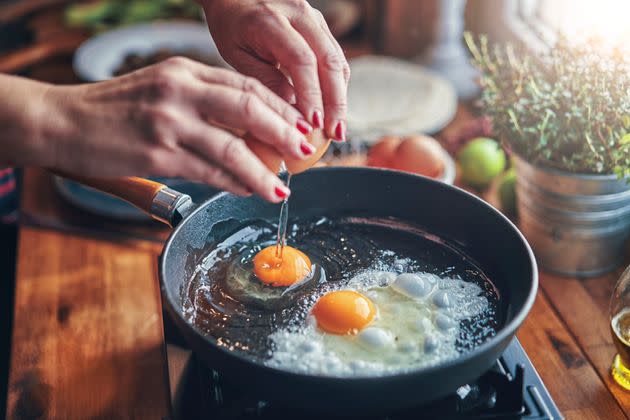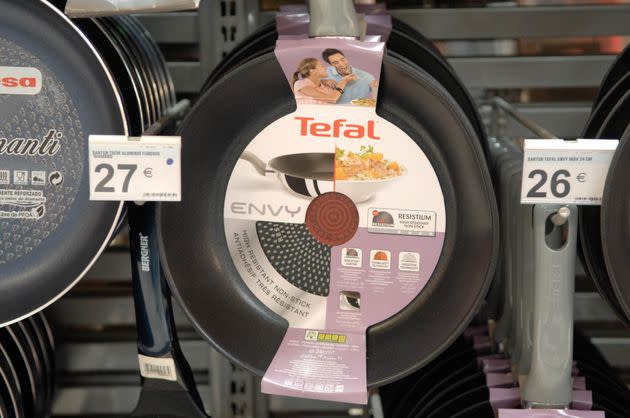Is Nonstick Cookware Safe? Are There Better, Less Controversial Alternatives?

Back in 1938, American scientist Roy J. Plunkett incidentally discovered a new substance that was later trademarked as Teflon.
Since then, the material has been used in a variety of capacities ― windshield wipers, hair products, graft material in surgeries, carpets and more, according to the American Physical Society’s APS News.
Perhaps most notably, Teflon is widely used for nonstick cookware. In 1954, French engineer Marc Grigoire “invented the first PTFE-coated nonstick cooking pans (brand name: Tefal) at the suggestion of his wife,” APS News wrote. The pans first appeared in the United States in 1961.
Fast-forward over six decades and Teflon is one of many different types of nonstick cookware on the market. Although certainly popular, the tools have been the subject of intense scrutiny and criticism, with detractors claiming they cause a variety of health issues, including cancer, reduced fertility rates, and thyroid and kidney disorders.
But do all varieties boast the same pros and cons? Are nonstick products considered safe or are there better options we should be considering?
Not all nonstick cookware is created equal.
“Nonstick cookware is made with a metal base that is usually aluminum or stainless steel that has been sandblasted to give it a ‘gritty’ surface for the nonstick coating to adhere to,” explains exposure scientist Samantha Radford. “Afterwards, the nonstick surface is sprayed onto the pan, often in multiple layers.”
To put it simply, the base layer of all nonstick pans and pots is the same, but the additional coating changes depending on what sort of product you’re dealing with. For example, Teflon cookware boasts a second layer that is made of polytetrafluoroethylene, or PTFE.
Throughout the years, the use of Teflon at high temperatures has been associated with a variety of health risks, including changes in liver enzymes, decreased vaccine response in children, high cholesterol levels, cancer and more. However, according to the Centers for Disease Control and Prevention, it is not Teflon itself that causes harm, but a chemical that was formerly used to make the product: perfluorooctanoic acid, or PFOA. The use of PFOA was officially banned in the United States in 2014.
Food scientist Bryan Quoc Le explained that “seasoned cast iron would be made up of a class of iron-carbon alloys that is then layered with polymerized oils used as a seasoning barrier.”
Other nonstick options include ceramic and enamel.
“The nonstick coatings form a barrier that prevents food, especially protein molecules, from binding to the surface of the metal,” Le said. “Normally, there are a number of sulfur-containing amino acids in foods, especially meat. These react to the metal in cookware and stick to it.” Nonstick coatings don’t react to these compounds and therefore are able to block the reaction from occurring with the base metal layer below.
Some nonstick barriers can break down when used at high temperatures or when scratched, whether while cooking or washing the product.
“Essentially, the heat from cooking weakens the chemical bond between the coating and the metal, allowing oxygen to enter and oxidize the materials,” Le said.
Take Teflon, for example, which “decomposes to tetrafluoroethylene, difluorocarbene, carbon monoxide and carbon dioxide when heated well past its decomposition temperature of 660 degrees Fahrenheit,” Le said. Those toxic chemicals can cause long-term health effects that mostly target the endocrine system and the reproductive system, Radford explained.
The Environmental Working Group found in a 2003 report that “in cases of ‘Teflon toxicosis,’ ... the lungs of exposed birds hemorrhage and fill with fluid, leading to suffocation,” adding that chemical company “Dupont acknowledges that the fumes can also sicken people, a condition called ‘polymer fume fever.’”

Enamel and ceramic pots and pans, on the other hand, start chipping away when heated above 450 degrees Fahrenheit. Stainless steel and other metals actually “don’t suffer from the same problem with heat as there is no barrier in which the material is bonded,” Le said.
There are pros to nonstick cookware.
Clearly, given its popularity, there is just something about nonstick cookware that, well, sticks. There are, indeed, benefits related to the products.
First of all, cooking using nonstick pots and pans will require less oil to keep the various foods from attaching to the surface. As a result, cleaning the various tools will also be easier.
“The perfluorinated chains in nonstick coatings are both hydrophobic and lipophobic, meaning they don’t stick to either water of fats/oils,” Radford said. “Because [of that], it’s easier to clean them after use.”
Convenience should also be kept in mind. Preparing scrambled eggs, for example, or lightly cooking some vegetables end up becoming easier tasks when not having to worry about them sticking and burning on the surface of the pots and pans they’re being made in.
There are also drawbacks.
“The convenience of nonstick cookware comes at a price,” Radford noted, specifically citing Teflon as the least healthy option when choosing nonstick products.
As noted above, the chemicals released by broken-down Teflon are so harmful that the benefits associated with the form might not be worth the risks. (“Teflon itself does not pose a health risk, so long as it does not decompose,” Le clarified.)
Although not to the extent of Teflon, pots and pans coated with ceramic can also lead to exposure to toxic compounds such as lead or titanium dioxide nanoparticles if the cookware decomposes, Radford explained.
As for other nonstick options, given the fact that they cannot be used at temperatures above 500 degrees Fahrenheit, cons include the inability to use them for grilling or searing, for example.
There is a proper way to use nonstick cookware.
Overall, the consensus seems to be that out of all nonstick cookware varieties, Teflon is the least safe to use. That being said, the risks associated with any nonstick pot or pan has loads to do with how the product is used, including the temperature at which the food is being cooked.
Other tips to keep in mind, according to experts: Don’t use the products in a home with birds as pets (“as they are extra sensitive to fumes,” Radford said), avoid open flames and replace your nonstick cookware as soon as it is scratched.
So… which nonstick cookware should we feel safe using?
Clearly, Teflon is your riskiest option, especially if not used properly. “Ceramic, enamel, seasoned cast iron and hard anodized aluminum are better options as they do not produce the same decomposition products as Teflon,” Le advised.
Radford specifically sang the praises of high-quality ceramic cookware (note: not just ceramic-coated options) and cast iron. “With proper seasoning, cast iron can also be nonstick,” Radford said. “Plus, it lasts forever and doesn’t release toxic chemicals. In fact, it can increase the nutrient content of your food because tiny amounts of iron will be released each time you cook with it — especially if it’s something as acidic as vinegar, citrus or tomatoes. With so many of us deficient in iron, this is great news.”
Alas, this may all change in the span of a few years or decades. As Radford noted, “once a chemical is OK’d for use, it takes a generation or two to see the health effects they cause.” Teflon, for example, was considered totally safe because it was analyzed in non-reactive conditions.
“Companies are by then making huge money off their products and they spend millions to lobby so that they are still allowed on the market,” Radford continued. “With that said, we will probably always have some form of nonstick cookware available.”

